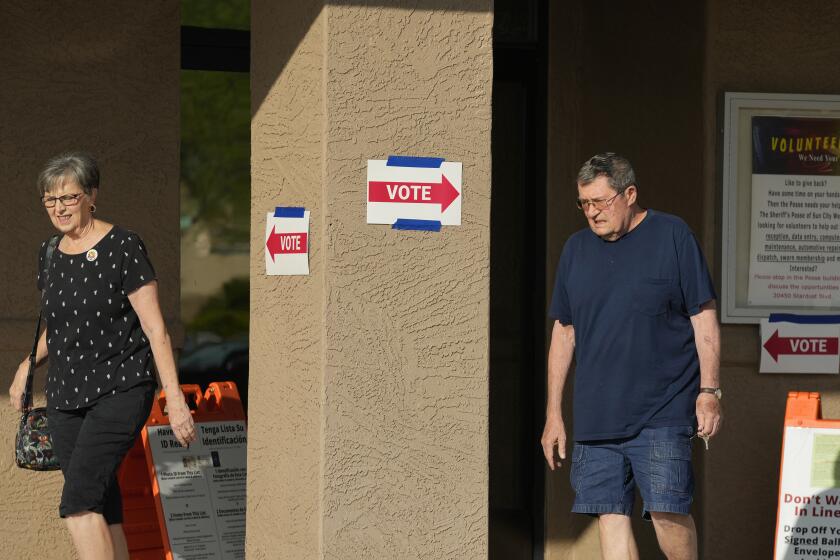Absentee Voters Make Their Mark
More than two-thirds of those who voted in the Jan. 28 special election to fill a seat on the Orange County Board of Supervisors did so by absentee ballot, setting a state record and offering what officials believe is a glimpse into the future.
Propelled by a new state law that makes it easier to vote without going to the polls, the campaign focused on locking up the support of absentee voters. The winner, former Assemblyman Bill Campbell, mailed absentee registration forms to 30,000 registered voters whom his research suggested would be likely to vote for him.
On election day, only 11,000 of the 36,000 people who voted did so at a polling place.
“That’s where elections are going,” said Tony Quinn, a veteran state political analyst and a former GOP strategist in Sacramento.
“What [Campbell] realized is that not many people are going to troop to the polls, but ‘I can get them with absentee.’ ”
Orange County’s elections department was one of the few in the state to publicize the new law that loosened absentee-voting rules. California Secretary of State Kevin Shelley attributed the high absentee rate in the 3rd District election to that outreach effort, coupled with Campbell’s aggressive courtship of absentee voters.
“It’s not a 9-to-5 work world,” he said. “It’s not the traditional Ozzie and Harriet walking arm in arm to the polling booth. That just isn’t the way it is, so you’ve got to accommodate that. Orange County made the first step.”
Kim Alexander, president of the California Voter Foundation, said she expects absentee voter numbers to rise elsewhere in the state -- especially in single-issue elections like the one in Orange County for which many voters did not go to the polls. But she and others worry that candidates’ increasing focus on absentee voters will decrease the amount of campaign literature that goes out to infrequent voters.
Absentee voting has been steadily rising over the last four decades.
Less than 3% of voters cast absentee ballots in November 1962, when only the sick, the infirm and those who would be out of town on election day were allowed to use them.
By last year’s general election, 27% voted absentee, according to the secretary of state’s office.
The highest absentee-voting rate state and local voting officials and political watchers could recall was about 50%. In Orange County, the highest absentee turnout in recent years was 54% in a 1995 special election to fill a vacant Assembly seat.
Tiny Alpine County has held elections in which all voters were required to cast their ballots by mail.
Laws allowing any citizen to vote absentee went into effect in 1978, but absentee ballots had to be requested before each election.
Last year, the Legislature allowed voters to become permanent absentee voters, meaning they would automatically receive ballots in the mail as long as they continued to vote.
Campbell and his campaign organizers decided early on to focus on wooing absentee voters because they predicted turnout would be minuscule in the one-race special election.
“Clearly, a majority of our money was spent communicating with either people who were absentee voters or past absentee voters or potential absentee voters,” said John Lewis, Campbell’s campaign manager.
Campbell’s campaign, which spent $270,000, combed the computerized voter registration rolls, selecting about 30,000 people to send absentee-voter registration forms to in December.
The most desirable voters were contacted as many as 10 times by mail, over the telephone and in person, Lewis said.
“We selected people that were frequent voters or perhaps past absentee voters and people we thought would be most likely to support Bill Campbell,” Lewis said. Campbell said: “We literally called every absentee where we could get a phone number on them.”
The strategy was highly successful: The race was essentially decided before the polls opened Jan. 28, and Campbell won 75% of the vote.
The results of the Orange County election were bittersweet for state officials. They were thrilled to see so many people using absentee ballots. However, what was supposed to drive up overall voter participation clearly did not. The turnout was among the lowest ever in the county.
Of the 277,007 registered voters in the 3rd Supervisorial District, which stretches from the rustic canyons of the Santa Ana Mountains to the master-planned community of Irvine, less than 13% cast ballots, according to the county registrar of voters.
“I was extremely excited, until I saw the 13%,” Shelley said. “The good news, obviously, is the high absentee participation. If that contributes to increasing the level of all participation, it’s a good thing. It’s a great thing, in fact.
“But what happened here is only 13% of the registered voters turned out. That’s not something to pop a champagne cork about.”
Alexander, of the nonprofit California Voter Foundation, worried that the strategy adopted by Campbell will become the norm.
“One of the trends I find troubling is what we call ‘voter profiling,’ which is where the campaigns are increasingly talking to a smaller and smaller audience,” she said.
“They get ahold of voter registration lists, figure out who is most likely to vote and inundate those voters with phone calls and messages.
“Some voters get heavily courted, while others are totally ignored,” she said.
Alexander said these methods lead to a self-fulfilling prophecy, where people who don’t vote regularly receive little information -- especially in low-interest special elections -- and therefore don’t vote because they know little about the race or issues.
“It’s frustrating,” she said, “because on one hand people get very upset about low voter turnout, but on the other hand, we have an electoral process that often perpetuates low voter turnout.”
*
Times staff writer Ray F. Herndon contributed to this report.
More to Read
Get the L.A. Times Politics newsletter
Deeply reported insights into legislation, politics and policy from Sacramento, Washington and beyond. In your inbox three times per week.
You may occasionally receive promotional content from the Los Angeles Times.











